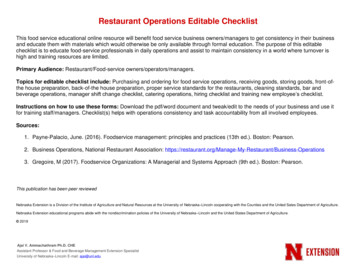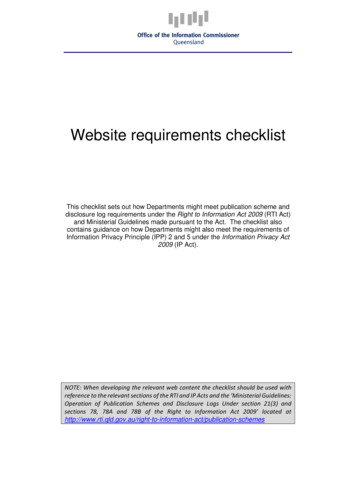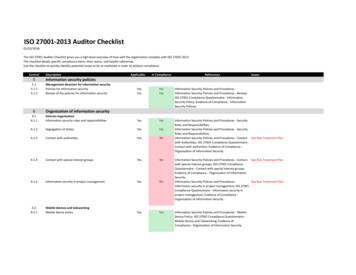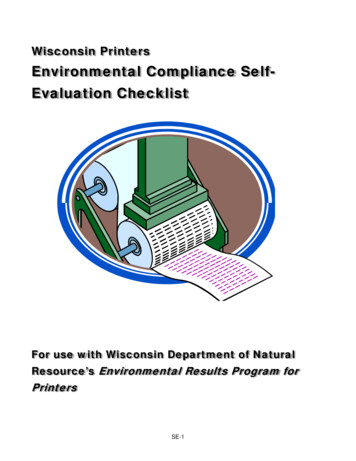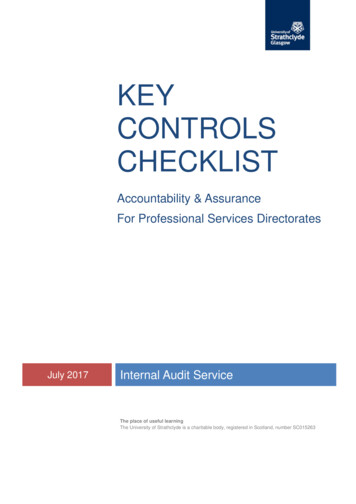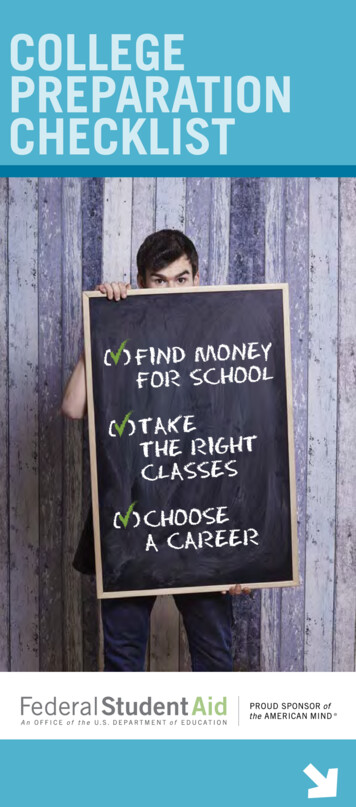
Transcription
COLLEGEPREPARATIONCHECKLIST( ) FIND MONEyFOR SCHOOL( ) TAKETHE RIGHTCLASSES( ) CHOOSEA CAREER
Why go to college? A higher educationintroduces students to new people andnew experiences and usually leads toa higher salary and lower chance ofunemployment. This checklist will tell youhow to get ready for college—and howthe government will help you pay for it.(Q:A:Q:A:Howto usethechecklist)Who should use the checklist?S tudents of all ages who haven’t attendedcollege, and parents of students in elementaryand secondary school.What is the checklist?A to-do list, starting with elementary school, tohelp students prepare academically and financiallyfor education beyond high school. Each sectionis split into subsections for students and parents,explaining what to do and which publications orwebsites might be useful to them.Q: When should a student or parent refer tothe checklist?A: At the beginning of every school year, and thenmore frequently as college approaches. (Or, in thecase of an adult student returning to school, assoon as possible!)StudentAid.gov1-800-4-FED-AID (1-800-433-3243)TTY: 1-800-730-8913
CONTENTSGetting a Late Start?.2MONEY FOR COLLEGEFederal Student Aid.4More Sources of Student Aid.6YOUR TO-DO LISTElementary School.8Junior High or Middle School.9High School.11Every Year in High School. 11Ninth Grade. 1210th Grade. 1311th Grade. 15Summer Before 12th Grade. 1612th Grade. 18Adult Students.21FAFSA Filing Time.221
GETTING A LATESTART?Just decided that you want to go to college,but school starts soon? Too late to do all thechecklist items in this document? Here is yourmust-do list.If School Starts Next Month() Apply for financial aid using the Free Application for() Ask the school you plan to attend what other financial() Keep in touch with the school about any paperwork youFederal Student Aid (FAFSA ) site at fafsa.gov. Turn to“FAFSA Filing Time” on page 22 of this checklist, andfollow the steps there to apply for federal, state, andschool funding.help it can offer you: Does it have last-minutescholarships or payment plans available? Can you get ajob on campus?need to turn in.If School Starts Next Week2() Apply for federal student aid immediately at fafsa.gov.() Talk to the financial aid office staff at the school youThe site has many resources, including live chat witha customer service representative, to help you as youcomplete the application.plan to attend. Ask whether there are other forms youneed to complete, and find out how and when you willreceive your financial aid.
MONEYFORCOLLEGEG3
FEDERALSTUDENT AIDWhat Is Federal Student Aid?Federal student aid comes from the federal government—specifically, the U.S. Department of Education. It’s moneythat helps a student pay for education expenses at acollege, career school, or graduate school.Federal student aid covers such expenses as tuition and fees,room and board, books and supplies, and transportation. Aidalso can help pay for a computer and for dependent care.There are three main categories of federal student aid: Grant—Grant money usually doesn’t have to be repaid.Most U.S. Department of Education grants are based on astudent’s financial need. Work-study—Work-study money is earned by a studentthrough a job on or near campus while attending schooland does not have to be repaid. Loan—Loan money must be repaid with interest.For details about the federal student aid programs,including maximum annual amounts and loan interest rates,visit StudentAid.gov/types.WHY GET A FEDERAL STUDENT LOAN?Federal student loans offer low fixed interest rates;income-based repayment plans; loan forgiveness;and deferment (postponement of repayment) options,including deferment of loan payments when a studentreturns to school. Generally, repayment of a federal loandoes not begin until after the student leaves school. Anddid you know that a student receiving a federal loan doesnot need a credit history or a cosigner? Private loans frombanks often do not offer such benefits. So if you need toborrow money to pay for college or career school, startwith federal student loans. More information is available atStudentAid.gov/federal-vs-private.4
Who Gets Federal Student Aid?Our most basic eligibility requirements are that you must demonstrate financial need (for most programs); be a U.S. citizen or an eligible noncitizen; have a valid Social Security number; be registered with Selective Service if you’re a male (youmust register between the ages of 18 and 25); be enrolled or accepted for enrollment as a regular studentin an eligible degree or certificate program; be enrolled at least half-time to be eligible for Direct LoanProgram funds; maintain satisfactory academic progress in college; sign a statement on the Free Application for FederalStudent Aid (FAFSA ) stating that-- you are not in default on a federal student loan and donot owe money on a federal student grant, and-- you will use federal student aid only for educationalpurposes; and show you’re qualified to obtain a postsecondaryeducation by-- having a high school diploma or recognized equivalent,such as a General Educational Development (GED)certificate or--completing a high school education in a homeschoolsetting approved under state law.Note: There are some additional requirements and exceptions.For more details about our eligibility criteria, visit StudentAid.gov/eligibility.How Do You Apply for Federal Student Aid?Refer to “FAFSA Filing Time” on page 22 of this checklist for astep-by-step guide to filling out the FAFSA.5
MORE SOURCESOF STUDENT AIDThe U.S. Department of Education is the main source offinancial aid for college, but it isn’t the only source. Visit StudentAid.gov/types#federal-aid to find out abouteducation funding available from other federal agencies. Visit www.ed.gov/sgt to find out about money available fromstate governments. Visit a college’s website or ask its financial aid office aboutmoney the school offers its students. Read the rest of this page to learn where to look forscholar ships from sources other than those listed above.Finding ScholarshipsEveryone wants free money to help them attend college.There are many types of scholarships (which don’t allrequire that you have outstanding grades!) and manydifferent organizations that provide them. Each scholarshipprovider has its own application and its own rules to decidewho can get its scholarship. Your job is to find scholarshipsfor which you think you might qualify and to apply by thedeadlines.And remember: There is no “secret” scholarship money outthere. You don’t need to pay a consultant or join a societyjust because they say they can help you find scholarships.You can find them yourself and save some money. Here aresome free sources of information:( ) the free scholarship search at StudentAid.gov/scholarships( ) a high school, Upward Bound, or Talent Searchcounselor( ) your library’s reference section( ) foundations, religious or community organizations, localbusinesses, or civic groups( ) organizations (including professional associations)related to your field of interest( ) ethnicity-based organizations( ) your employer or a parent’s employer6
YOURTO-DOLISTG7
ELEMENTARYSCHOOLStudentsTO DO:( ) Do your best in school.( ) Read a lot.( ) Have fun learning!TO EXPLORE:( ) Visit www.kids.gov to learn about jobs and to find funonline games.( ) Check out the Kids’ Zone at nces.ed.gov/nceskids if youlike such games as puzzles and math teasers.ParentsTO DO:( ) Help your kindergartner develop an interest in readingby reading aloud to him or her.( ) Check your child’s homework and follow his or herprogress in school by looking at report cards andattending teacher conferences.( ) Start saving for your child’s college education. Learnabout the tax advantages of state-offered collegesavings plans and prepaid tuition plans atwww.collegesavings.org.TO EXPLORE:8() Read Saving Early Saving Smart! at StudentAid.gov () Check out Helping Your Child Become a Reader at/resources#saving-early. This handout explains whyit’s never too early to save money for college and howto use such resources as college savings plans andfederal student aid.www.ed.gov/parents/academic/help/hyc.html for adviceon how to create a foundation for learning for childrenup to age 6. The publication provides a list of resourcesfor parents and includes activities that turn dailyroutines into learning experiences.
JUNIOR HIGH ORMIDDLE SCHOOLStudentsTO DO:( ) Think about college as an important part of your future.Discuss your thoughts and ideas with your family andwith people at school.( ) Start saving for college if you haven’t already.( ) Take challenging and interesting classes to prepare forhigh school. () Ask your parent or guardian to help you research whichhigh schools or special programs will most benefit yourinterests.( ) Develop strong study habits.( ) Do your best in school and on standardized tests. Ifyou are having difficulty, don’t give up—get help from ateacher, tutor, or mentor.() Become involved in school- or community-based() Speak with adults, such as your teacher, schoolactivities that let you explore your interests and learnnew things.counselor or librarian, relatives, or family friends, whoyou think have interesting jobs. Ask them what theylike about their job and what education they neededfor it.TO EXPLORE:( ) Find out why you should prepare for college now atStudentAid.gov/prepare.( ) Browse My Future, My Way: First Steps Toward College,a workbook for middle and junior high school students,at StudentAid.gov/resources#my-future.9
ParentsTO DO:( ) Use FAFSA4caster at fafsa.gov to find out how muchfederal student aid your child might receive. Thisinformation will help you plan ahead.( ) Continue saving for your child’s college education. Ifyou have not opened a savings account, you can findinformation about tax advantages and links to state plansat www.collegesavings.org.( ) Talk to your child about his or her interests and helpmatch those interests with a college major and career.( ) Help your child develop good study habits, such asstudying at the same time and place every day and havingthe necessary materials to complete assignments.( ) Stay in contact with your child’s teachers and counselorso that they can let you know about any changes in yourchild’s behavior or schoolwork.( ) Keep an eye on your child’s grades, and help him or herfind tutoring assistance, if necessary.TO EXPLORE:() Get tips from the following documents at g Your Child With Homework offers suggestionson how to empower your child to successfully completeassignments.-- Helping Your Child Through Early Adolescence addressesissues that parents of 10- to 14-year-olds generally findmost challenging. (10) Browse Parent Power at et.pdf for ideas to help you supportyour child as he or she transitions into high school.
HIGH SCHOOLEvery Year in High SchoolStudentsTO DO:( ) Work with a parent to estimate your potential financial aidusing FAFSA4caster at fafsa.gov, and continue to save forcollege.( ) Take challenging classes in core academic subjects.Most colleges require four years of English, at leastthree years of social studies (history, civics, geography,economics, etc.), three years of math, and threeyears of science. Many require two years of a foreignlanguage. Round out your course load with classes incomputer science and the arts.( ) Stay involved in school- or community-based activitiesthat interest you or let you explore career interests.Consider working or volunteering. Remember that it’squality—not quantity—that counts.( ) Talk to your school counselor and other mentors abouteducation after high school. Your counselor can answerquestions about what classes to take in high school,how to sign up for standardized tests, and where to getmoney for college.TO EXPLORE:( ) Check out KnowHow2Go: The Four Steps to College, atwww.knowhow2go.org for more advice on actions you cantake as you start thinking about education beyond highschool.( ) Get answers to common questions about college bywatching our videos on the “Prepare for College” playlistat www.YouTube.com/FederalStudentAid. () Learn about managing your money in the“High School Youth” section of www.mymoney.gov/Pages/for-youth.aspx.11
ParentsTO DO:( ) Continue to talk to your child about college plans as ifhe or she will definitely go to college.( ) Keep an eye on your child’s study habits and grades.Stay involved.( ) Encourage your child to take Advanced Placementcourses or other challenging classes.( ) Add to your child’s college savings account regularly.TO EXPLORE:( ) Explore StudentAid.gov/parent for information onsaving for college, borrowing for college, applying forfinancial aid, getting tax benefits to help make collegeaffordable, and more.Ninth GradeStudentsTO DO: () Review “Every Year in High School” on page 11 of this () Talk to your school counselor or teachers about () Use the career search at StudentAid.gov/careersearch () Make a list of your awards, honors, extracurricularchecklist.Advanced Placement courses. Find out what coursesare available, whether you are eligible, and how toenroll in them.to research your career options.activities, and paid and volunteer work. Considerparticipating in academic enrichment programs,summer workshops, and camps with specialty focusessuch as music, arts, or science.TO EXPLORE: () Visit StudentAid.gov/whycollege for a quick rundown on () Find ways to get help preparing for college at12why deciding to attend college is a no-brainer.StudentAid.gov /prepare-for-college/help.
ParentsTO DO: () Review “Every Year in High School” on page 11 of this () Make sure you are fully aware of the provisions of anychecklist.college savings accounts you have opened for your child.TO EXPLORE: () Learn about the tax benefits of cashing in savingsbonds to pay for your child’s education; search for“Publication 970” at www.irs.gov.10th GradeStudentsTO DO: () Review “Every Year in High School” on page 11 of this () Meet with your school counselor or mentor to discuss () Consider taking a practice Preliminary SAT/National () Plan to use your summer wisely: Work, volunteer, or () Go to career information events.) Research majors that might be a good match (checklist.colleges and their admissions requirements.Merit Scholarship Qualifying Test (PSAT/NMSQT ) orPSATTM 10, or the PreACTTM.take a summer course (away from home or at a localcollege).with your interests and goals. Consider what fitswell with your results from the career search atStudentAid.gov/careersearch.TO EXPLORE: () Learn the differences between grants, loans, work- () Think about starting to research different colleges.study, and scholarships at StudentAid.gov/types.Play around with the College Scorecard tool atcollegescorecard.ed.gov to explore schools based on size,location, programs, and more.13
ParentsTO DO: () Review “Every Year in High School” on page 11 of this () Find out whether your child’s school has college nights. () Help your child develop independence by encouragingchecklist.Plan to attend those events with your child.him or her to take responsibility for balancing homeworkwith other activities or a part-time job.TO EXPLORE: () Learn about the standardized tests your child will () Get a brief overview of financial aid from Federal14take during 10th, 11th, and 12th grades: thePSAT/NMSQT or PSAT 10, SAT and SAT Subject Tests(see www.collegeboard.org), and/or the PreACT andthe ACT (see www.act.org).Student Aid at a Glance at StudentAid.gov/glance.
11th GradeStudentsTO DO:.all year () Review “Every Year in High School” on page 11 of this () Explore careers and their earning potential with the () Learn about choosing a college (and find a link () Go to college fairs and college-preparationchecklist.Occupational Outlook Handbook search tool atwww.bls.gov/oco.to our free college search tool) at StudentAid.gov/prepare-for-college /choosing-schools.presentations hosted by college representatives.fall () Take the PSAT/NMSQT.* You must take the test in11th grade to qualify for scholarships and programsassociated with the National Merit ScholarshipProgram.spring () Register for and take exams for college admission.* The () Use the free scholarship search tool attests that many colleges require are the SAT, the SATSubject Tests, and the ACT. Check with the colleges youare interested in to see what tests they require.StudentAid.gov/scholarships to find scholarships forwhich you might want to apply. Some deadlines fall asearly as the summer between 11th and 12th grades,so prepare now to submit applications soon.TO EXPLORE: () Visit www.YouTube.com/FederalStudentAid and go to the () Learn how to avoid scholarship scams and identity theft“Types of Aid” playlist to see how the government canhelp you pay for college.at StudentAid.gov/scams.*REMEMBER: Register for all tests in advance, and besure to give yourself time to prepare appropriately! If youhave difficulty paying a registration fee, ask your schoolcounselor about getting the fee waived.15
ParentsTO DO: () Review “Every Year in High School” on page 11 of this () Take another look at your financial situation, and be () Talk to your child about the schools he or she is () Attend college fairs with your child, but don’t take over () Take your child to visit college campuses, preferably () Attend any financial aid information events at yourchecklist.sure you’re on the right track to pay for college.considering. Ask why those schools appeal to yourchild, and help him or her clarify goals and priorities.the conversation with the college representatives. Justlisten; let your child do the talking.when classes are in session.child’s school.TO EXPLORE: () Get in-depth information on federal student aid () Learn about student and parent loans in the Federalprograms at StudentAid.gov/types.Student Loans: Basics for Students and FederalStudent Loans: Direct PLUS Loan Basics for Parentsbooklets at StudentAid.gov/resources#loans.Summer Before 12th GradeStudentsTO DO:( ) Create a username and password called an FSA ID thatyou’ll use to confirm your identity when accessing yourgovernment financial aid information and electronicallysigning your federal student aid documents. You and yourparent will each need your own unique FSA ID. Learnabout the FSA ID, and create yours, at StudentAid.gov/fsaid. Note: You must create your own FSA ID; if yourparent creates it for you, that’ll cause confusion later andwill slow down the financial aid application process. ( 16) Narrow down the list of colleges you are consideringattending. If you can, visit the schools that interest you.
( ) Contact colleges to request information andapplications for admission. Ask about financial aid,admission requirements, and deadlines. () Decide whether you are going to apply under a () Apply for scholarships. Your goal is to minimize theparticular college’s early decision or early actionprogram. Be sure to learn about the program’sdeadlines and requirements.amount of loan funds you borrow so you have less topay back later.TO EXPLORE: () Find out what government financial aid you can apply () Watch the “Overview of the Financial Aid Process” () Be careful when searching for scholarships. Readfor, and how, in Federal Student Aid at a Glance atStudentAid.gov /glance.vi
such as a General Educational Development (GED) certificate or - completing a high school education in a homeschool setting approved under state law. Note: There are some additional requirements and exception


